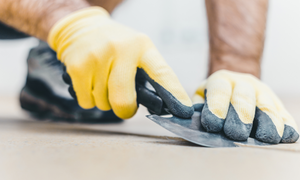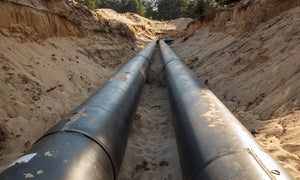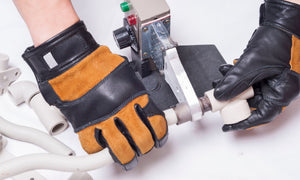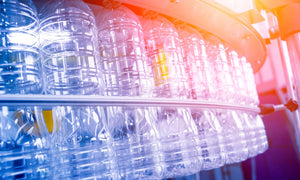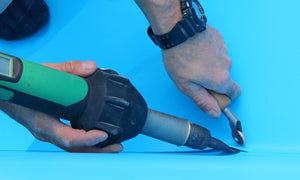The Role of Plastic Welding in Commercial Flooring

When it comes to commercial flooring, durability, aesthetics, and cost-effectiveness are key considerations. One critical aspect often overlooked in the installation and maintenance of commercial flooring is the role of plastic welding. Plastic welding is a versatile and efficient process that is instrumental in creating seamless, sturdy, and visually appealing floors. Below, we will explore how plastic welding plays a pivotal role in commercial flooring projects.
What is Plastic Welding?
Plastic welding is a process used to join two plastic surfaces together by melting the plastic material and then allowing it to fuse and solidify. This technique can be applied to a variety of plastic types, including polyvinyl chloride (PVC), vinyl, polyethylene, and other polymers commonly used in commercial flooring. The process can be performed using different methods, such as hot air, extrusion, and ultrasonic welding.
>>Related read: Repairing Vinyl Floor? Use These Tools for an Efficient Plastic Weld
Why Choose Plastic Welding for Commercial Flooring?
Plastic welding offers unparalleled benefits for commercial flooring installations. So, what makes it a top choice for various commercial spaces? Read below to find out.
Creating Seamless Floors
One of the most significant benefits of plastic welding in commercial flooring is the ability to create seamless floors. By welding the seams between individual flooring panels, a smooth and continuous surface is achieved. This enhances the floor's visual appeal and improves safety by eliminating tripping hazards.
Enhanced Durability and Longevity
Properly welded plastic flooring joints are strong and resilient, reducing the risk of water damage, warping, and wear over time. This durability is crucial in commercial settings, where floors often experience heavy foot traffic and other forms of stress.
Cost Effectiveness
Related, the durability and longevity of welded plastic flooring can lead to cost savings over time due to reduced maintenance and repair needs. Properly welded floors can withstand heavy use, minimizing the need for frequent replacements and repairs.
Improved Hygiene and Cleanliness
Seamless floors created through plastic welding are easier to clean and maintain. With fewer crevices for dirt and bacteria to accumulate, the overall hygiene of the floor is improved, making it ideal for healthcare facilities, food processing plants, and other environments where cleanliness is paramount.
Customizable and Versatile Design
Plastic welding allows for a high degree of customization in commercial flooring design. Seamless floors can be installed in various patterns, colors, and textures to suit the aesthetic preferences and branding of a particular business. This versatility enables designers to create unique and visually appealing spaces.
Environmentally Friendly
Many modern plastic welding methods and materials are designed with sustainability in mind. Some plastics used in flooring can be recycled, and the longevity of welded floors reduces waste from replacements.
Common Plastic Welding Methods for Commercial Flooring
There are two methods of plastic welding commonly used in commercial flooring projects. Continue scrolling to learn more about them.
Hot Air Welding
In hot air welding, a hand-held hot air gun is used to melt the plastic edges of flooring panels. A welding rod made of the same material as the flooring is then melted and fused into the joint. This method is widely used for its simplicity and effectiveness.
Chemical Welding
Chemical welding involves applying a chemical solution to the edges of the plastic materials being joined. It softens the surfaces, allowing them to fuse together as the solution evaporates. In flooring applications, chemical welding can be useful for joining specific types of plastics, such as PVC or vinyl, to create smooth and seamless connections. These plastic welding methods offer various advantages depending on the specific needs of the commercial flooring project. Selecting the appropriate method will depend on the materials being used, the desired finish, and the overall project requirements.
>>Related read: 5 Expert Plastic Welding Techniques and How to Master Them
Key Considerations for Plastic Welding in Commercial Flooring
To achieve the best results in commercial flooring projects, there are a few key considerations to keep in mind when using plastic welding:
- Material Compatibility: Ensure that the welding rod and flooring materials are compatible in terms of composition and properties. This compatibility is crucial for achieving a strong and durable weld.
- Proper Training and Expertise: Plastic welding requires skill and precision. It is essential to work with experienced professionals who understand the nuances of the process and can execute it effectively.
- Quality Control: Regular inspections and quality checks should be conducted throughout the welding process to ensure a consistent and high-quality finish.
- Environmental Conditions: The ambient temperature and humidity can impact the quality of the weld. It is important to conduct welding under optimal conditions to achieve the best results.
- Surface Preparation: Properly preparing the flooring surfaces to be welded is crucial. This includes cleaning and possibly roughening the surfaces to ensure a strong bond and smooth, even weld.
- Regular Equipment Maintenance: Regular maintenance and calibration of welding equipment are necessary for consistent performance and high-quality results.
- Safety Precautions: Adhering to safety protocols is essential to protect the welder and others in the area. Proper ventilation and the use of personal protective equipment are important considerations.
- Project Planning: Thorough planning and layout design can help optimize the welding process and achieve a seamless appearance. Proper planning ensures efficient use of materials and time.
- Expansion and Contraction: Accounting for potential expansion and contraction of flooring materials due to temperature changes can help prevent cracking or warping at welded seams.
- Compliance with Regulations: Ensure that the materials and methods used meet local building codes and industry standards for safety and quality. This includes verifying certifications and specifications for welding materials and equipment.
Following these guidelines can help you create attractive, long-lasting flooring solutions that meet the demands of commercial environments and exceed customer expectations.
Top Plastic Welding Tools for Commercial Flooring
When it comes to plastic welding for commercial flooring, having the right tools is essential to ensure a professional, durable, and seamless installation. Here are some top plastic welding tools and accessories that can make your flooring projects more efficient and effective:
- Hot Air Hand Tool or Automatic Welding Machine: A hot air hand tool—such as the Steinel HG 2220 E Hot Air Tool or Ritmo HD-Pro Flow-Line Hot Air Tool—or automatic welding machine, such as the Forsthoff-F Automatic Welding Machine, is indispensable for controlled and consistent application of heat to weld plastic materials. The tool you select will be based on the size and scope of the project.
- Adapter Nozzle and Welding Nozzle: These nozzles, used with a hot air hand tool, help direct and control the flow of hot air, allowing for precise welding along seams and corners. Some examples include the IHS 5 mm diameter Tubular/Adapter Nozzle and IHS 5 mm diameter Round Speed Welding Nozzle.
- Silicone Seam Roller: A silicone seam roller, such as the IHS 2-in. Wide Silicone Seam Roller, is used to eliminate floor seams by ensuring smooth and even pressure across welded areas. This tool is perfect for achieving a clean and seamless finish.
- Brass Penny Roller: Ideal for rolling tight corner joints, the brass penny roller ensures a smooth and uniform weld in hard-to-reach areas, such as edges and corners. Options like the IHS Brass Penny Roller can help you achieve this.
- Knife and Seam Probe Kit: The IHS Knife & Seam Probe Kit includes a knife and seam probe, which are essential for cutting excess plastic and checking the integrity of the weld. These tools help achieve a flawless and professional appearance.
- Quarter Moon Knife: A quarter moon knife, like this IHS option, is specifically designed to trim excess plastic along welded seams.
- Skiving Knife: A skiving knife, such as the Forsthoff Handheld Skiving Knife, is used to cut grooves with minimal hand fatigue, making it an ideal tool for creating clean and precise grooves in the flooring.
- Stainless Steel Brush: After welding is complete, a stainless steel brush can be used to remove waste and debris from your hot air tool, ensuring it remains in good working condition.
- Thermo-Groover: The thermo-groover is designed to cut clean grooves in synthetic rubber and thermoplastics. This tool helps prepare the flooring for the welding process and ensures a smooth, even weld.
Having these top plastic welding tools on hand can help you achieve exceptional results in your commercial flooring projects. Proper use and maintenance of these tools also will contribute to the longevity and visual appeal of the finished floor.
Elevate Your Plastic Welding Capabilities with These Flooring Tools and Services
When it comes to commercial flooring projects, partnering with experienced professionals who specialize in plastic welding can make all the difference in achieving exceptional results. Whether you need assistance choosing the right plastic welding tool for your commercial flooring application or a repair and rental tool, you can find what you need at IHS. Contact us today for white-glove service and assistance from one of our experienced team members.
- Robert Heater


